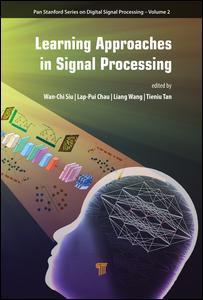Learning Approaches in Signal Processing Jenny Stanford Series on Digital Signal Processing Series

Coupled with machine learning, the use of signal processing techniques for big data analysis, Internet of things, smart cities, security, and bio-informatics applications has witnessed explosive growth. This has been made possible via fast algorithms on data, speech, image, and video processing with advanced GPU technology. This book presents an up-to-date tutorial and overview on learning technologies such as random forests, sparsity, and low-rank matrix estimation and cutting-edge visual/signal processing techniques, including face recognition, Kalman filtering, and multirate DSP. It discusses the applications that make use of deep learning, convolutional neural networks, random forests, etc. The applications include super-resolution imaging, fringe projection profilometry, human activities detection/capture, gesture recognition, spoken language processing, cooperative networks, bioinformatics, DNA, and healthcare.
Tutorial And Overview Of Learning Approaches Introduction to Random Tree and Random Forests for Fast Signal Processing and Object Classification. Sparsity Based Dictionary Learning Techniques. A Comprehensive Survey of Persistent Homology for Pattern Recognition. Low-Rank Matrix Estimation and Its Applications in Signal Processing and Machine Learning. Introduction to Face Recognition and Its Recent Work. Filter Design And Multirate Signal Processing The Ensemble Kalman Filter. Teaching Programming and Debugging Techniques for Multirate Signal Processing. Imaging Technologies Learning Approaches for Super-Resolution Imaging. Non-Contact Three-Dimensional Measurement Using the Learning Approach. Biometrics And Health Applications Computational and Learning Aspects of DNA Sequences. Visual Food Recognition for Dietary Logging and Health Monitoring. Motions In Videos, Pose Recognition And Human Activity Analysis Learning Randomized Decision Trees for Human Behavior Capture. Deep Learning in Gesture Recognition Based on sEMG Signals. Tutorial And Overview Of Learning Approaches Introduction to Random Tree and Random Forests for Fast Signal Processing and Object Classification. Sparsity Based Dictionary Learning Techniques. A Comprehensive Survey of Persistent Homology for Pattern Recognition. Low-Rank Matrix Estimation and Its Applications in Signal Processing and Machine Learning. Introduction to Face Recognition and Its Recent Work. Filter Design And Multirate Signal Processing The Ensemble Kalman Filter. Teaching Programming and Debugging Techniques for Multirate Signal Processing. Imaging Technologies Learning Approaches for Super-Resolution Imaging. Non-Contact Three-Dimensional Measurement Using the Learning Approach. Biometrics And Health Applications Computational and Learning Aspects of DNA Sequences. Visual Food Recognition for Dietary Logging and Health Monitoring. Motions In Videos, Pose Recognition And Human Activity Analysis Learning Randomized Decision Trees for Human Behavior Capture. Deep Learning in Gesture Recognition Based on sEMG Signals. Measuring Precise Inter-Person Physiological Synchrony and Its Trends through Adaptive, Data-Driven Algorithms: Combining NA-MEMD and the Synchrosqueezing Transform to Identify Synchronised Respiratory and HRV Frequencies. Language Processing, Cooperative Network And Communications Multitask Cooperative Networks and their Diverse Applications. Spoken Language Processing: From Isolated Word Recognition to Neural Representation of Syntactical Structures, Based upon Kernel Memory. Discussion On Ai For Healthcare The Brave New World of Machine Paulina Chan and Stephen K. NgLearning in AI and Medicine. Measuring Precise Inter-Person Physiological Synchrony and Its Trends through Adaptive, Data-Driven Algorithms: Combining NA-MEMD and the Synchrosqueezing Transform to Identify Synchronised Respiratory and HRV Frequencies. Language Processing, Cooperative Network And Communications Multitask Cooperative Networks and their Diverse Applications. Spoken Language Processing: From Isolated Word Recognition to Neural Representation of Syntactical Structures, Based upon Kernel Memory. Discussion On Ai For Healthcare The Brave New World of Machine Learning in AI and Medicine.
Wan-Chi Siu, a PhD graduate of Imperial College London, is emeritus professor and was chair professor, head (Electronic and Information Engineering), and dean of the Engineering Faculty of the Hong Kong Polytechnic University. He was the convener of the First Engineering/IT Panel of the 1993 Research Assessment Exercise in Hong Kong and vice president, conference board chair, and core member of the Board of Governors of the IEEE Signal Processing Society (2012–2014). Prof. Siu is a life-fellow of the IEEE, fellow of the IET and the HKIE, and president (2017–2018) of the Asia Pacific Signal and Information Processing Association. He has been a guest editor/subject editor/associate editor for IEEE Transactions on Circuits and Systems, Image Processing, Circuits and Systems for Video Technology, and Electronics Letters, published over 500 research papers, and organized IEEE-sponsored flagship conferences as the TPC chair (ISCAS1997) and general chair (ICASSP2003 and ICIP2010).
Lap-Pui Chau works in the School of Electrical and Electronic Engineering, Nanyang Technological University, Singapore, and is a fellow of the IEEE. He was chair of the Technical Committee on Circuits and Systems for Communications of the IEEE Circuits and Systems Society (2010–2012) and has served as an associate editor for five IEEE journals. Dr. Chau has also been an IEEE Distinguished Lecturer (2009–2016).
Liang Wang is full professor at the Institute of Automation, Chinese Academy of Sciences; deputy director of the National Laboratory of Pattern Recognition, China; secretary-general of the Technical Committee on Computer Vision, China Computer Federation; and director of the Technical Committee on Visual Big Data, China Society of Image and Graphics. He is a senior member of the IEEE and a fellow of the International Association of Pattern Recognition.
Tieniu Tan, a PhD graduate of Imperial College London, joined the Instit
Date de parution : 11-2018
15.2x22.9 cm
Thèmes de Learning Approaches in Signal Processing :
Mots-clés :
Random Forests; Non-leaf Node; Binary Test; Persistent Homology; Leaf Node; Convolutional Layers; Data Set; CNN Model; Training Patches; Multirate Signal Processing; Hr Image; LR Image; EnKF; Decision Tree; HRV Signal; Image De-noising; Image Patch; sEMG Signals; Nonleaf Node; AR Model; Fringe Image; Convolution Layer; Fringe Pattern; Phase Unwrapping; Code Pattern



